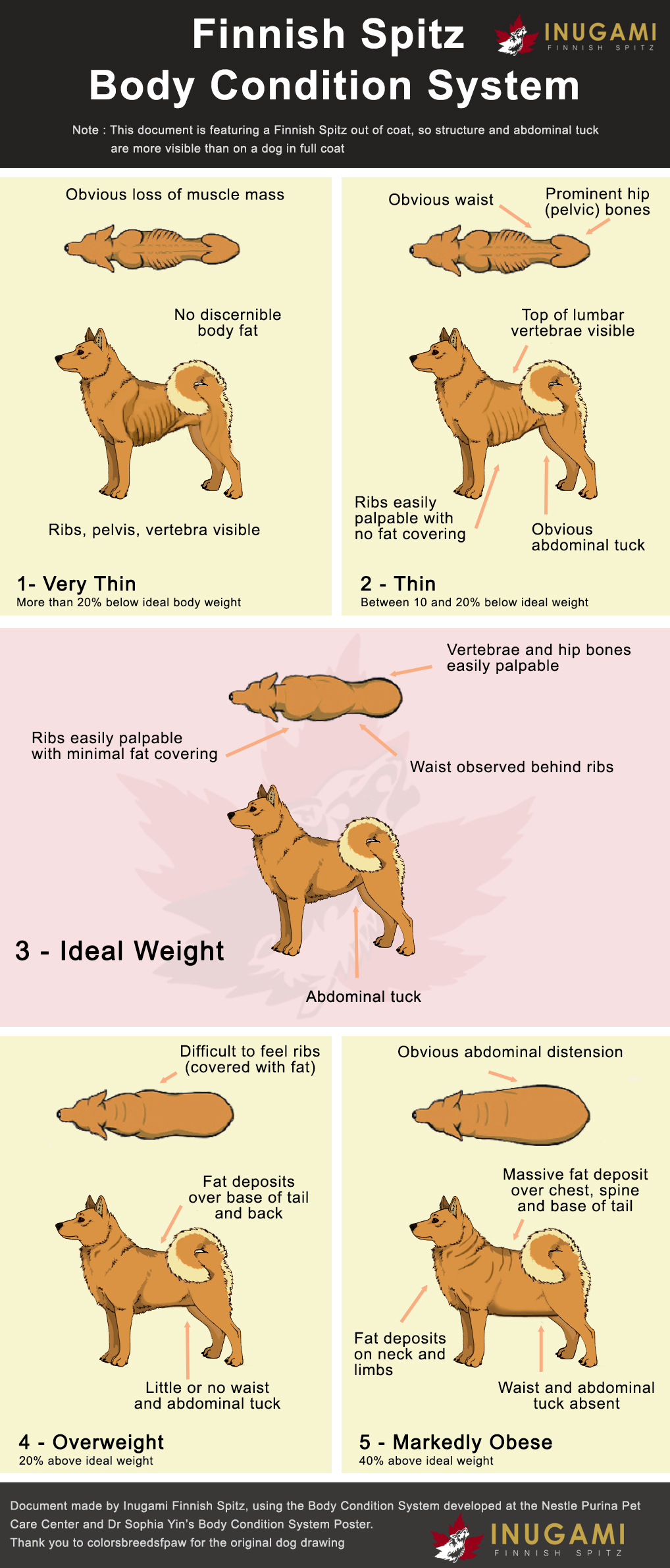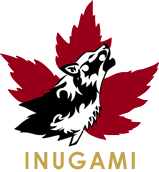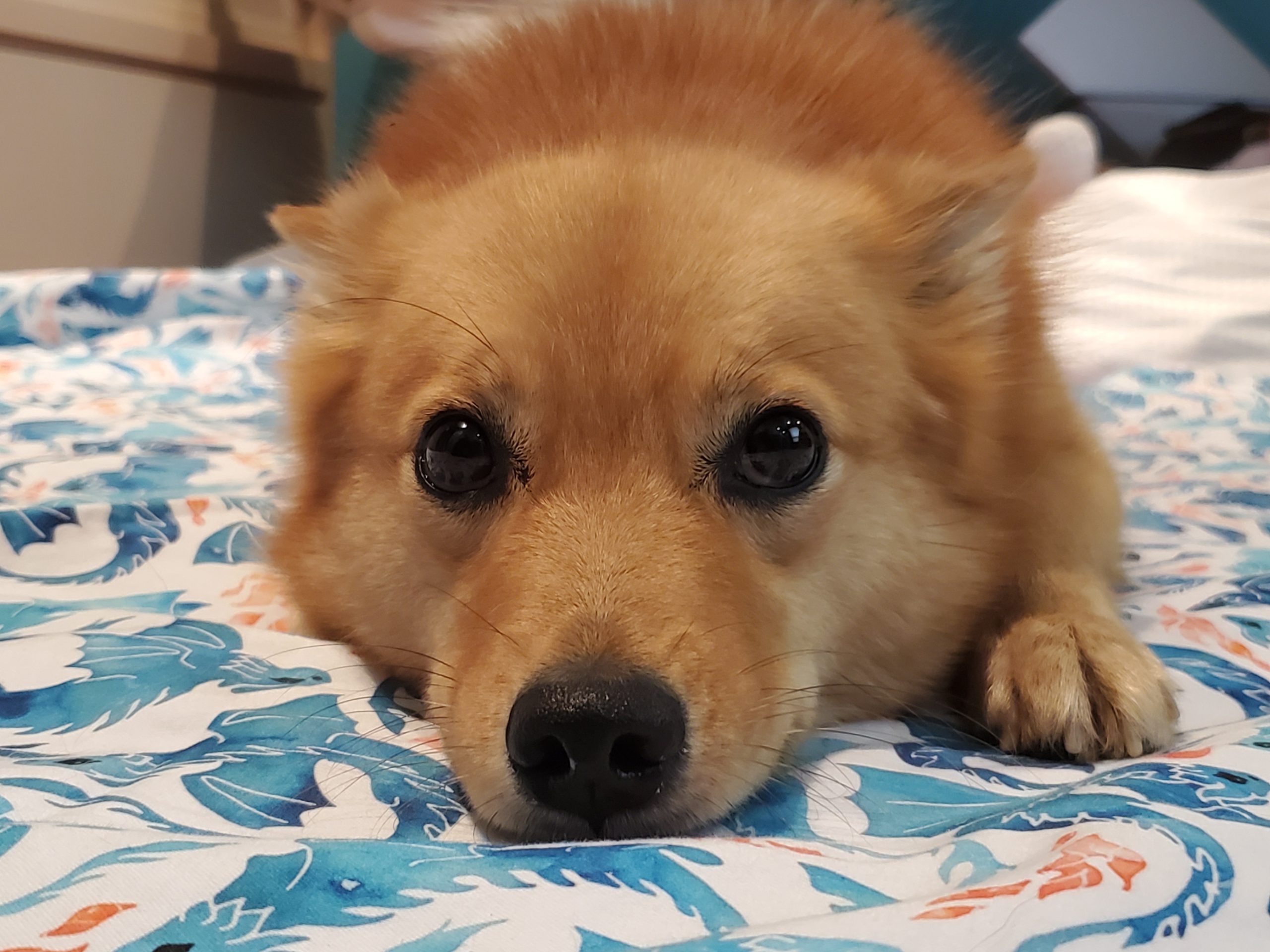Simple Ways to Help Your Finnish Spitz Lose Some Weight
Obesity can be a real problem for Finnish Spitzes. An overweight dog has an elevated risk of injury, illness and disease, including Patellar Luxation and Hip Dysplasia. So, it’s important to monitor your dog weight and if needed, to take action to help him become healthier by losing those extra pounds.
The good news is, the process of helping your dog is not really complicated or difficult.
Part of the solution is to learn to Body Condition Score your dog
Here is a chart based on Dr. Sophia Yin’s work and the Nestle Purina’s Body Condition Score system developed in 1997. Thanks to it, you will be able to Body Condition Score (BCS) your Finnish Spitz and learn if he has some weight to lose.

Dogs who are a body condition score of 1 are way too thin—generally truly starving due to illness or poverty. They look like walking skeletons because their poor nutrition has lead to muscle wasting in addition to the loss of fat.
On the opposite end of the spectrum is the body condition score of 5. This is the dog that looks like a giant, overstuffed sausage. He has huge fat deposits over the chest, spine and base of the tail such that his back resembles a table top rather than a living animal. He also has obvious abdominal distension due to fat in the abdomen.
The ideal dog is 3. Dogs with a body condition score of 3 have ribs and vertebrae that you can easily feel. You can see a waist right behind the ribs when viewing from the top, and from the side you can see the abdomen tucks up.
It’s pretty straightforward if your Finkie is out of coat and you go based on the chart included above. But if in doubt, your veterinarian should be able to help you.
Is Your Finnish Spitz Overweight? Here are simple ways to help your dog lose some weight
- Feed a high-quality dog food :
We are not going to get into the debate about whether kibble, canned, home-cooked or raw-food diets are best, but you should avoid cheap dog food brands that are high in corn or other grains and choose brands that have a high meat content (with no by-products). The Dog Food Advisor website is a good resource for checking and comparing different brands of dog food or you can also refer to your veterinarian for suggestions. - Understand feeding recommendations :
Don’t assume the feeding instructions on the packaging of your dog’s food apply to every dog. Finnish Spitzes are called ”easy keepers” since they can maintain a high energy level with a small amount of food. Usually, an adult Finnish Spitz will be satisfied with as little as 1 cup of kibbles per day. So, if your Finnish Spitz is gaining weight and you’re not overfeeding with treats or other food, gradually cut back on the amount of food you are giving him each day. - Measure your dog’s food :
Use a measuring cup to carefully measure each feeding. It’s an easy way to know exactly how much food your dog is eating at each meal and to make gradual adjustments if needed. - Weigh your dog regularly :
According to his standard, an adult Finnish Spitz weight should range between 31 to 35lbs for a male and 22 to 29 lbs for a female. So keep those weights in mind and if you need to adjust his food ratio, monitor your Finnish Spitz weight loss at least once a week. The goal when losing weight should be for your dog to lose about 1% of his body weight per week until he reaches his ideal body weight. - Manage your dog’s hunger :
Your Finnish Spitz might be a little hungry while he’s losing weight. If you normally feed once a day, try breaking the meal into two or three feedings throughout the day. You can also set aside a little of your dog’s daily food portion to use in a treat dispensing toy for later in the evening. You can also add some canned pumpkin or green beans, which are low-calorie fillers, to help your dog feel full during his new diet. - Increase his daly exercise :
Small increases in exercise can make a big difference. Make your daily walk just a bit longer or incorporate more play time into each day. Just like with your dog’s diet, you’ll want to make gradual changes so you don’t overwork your dog, especially if he’s very overweight or out of shape. - Reduce, or eliminate, unhealthy treats :
Have you ever given your Finnish Spitz a large treat or piece of food that he swallowed instantly? Dogs don’t really notice how big a treat is, they’re just happy to get one.
Small, low-calorie training treats are perfect for rewards or simply break bigger treats into small pieces. Your dog will be just as satisfied and you’ll be feeding him fewer calories each time.Try some healthier treats. Many dog treats found in pet stores are high in calories and carbohydrates. You can almost eliminate your dog’s treat calories by replacing them with much healthier snacks. Skip the hot dogs, cheese and peanut butter and see if your dog likes fresh fruits or vegetables. Celery, baby carrots, green beans, broccoli, cucumber slices and apple slices (take out any seeds first) are all great options. You can also put some of your dog’s daily kibble allowance in a container and use this as a treat throughout the day.
Just make sure you’re familiar with foods you shouldn’t feed your dog before feeding any human foods and remember that treats should make up no more than 10% of your dog’s total daily diet.Use different rewards. Using food to motivate or reward a dog works pretty well but we tend to forget that many dogs would be just as happy with a good belly rub or a play session for a reward. Try mixing it up to see if your dog will respond to other things rather than always relying on a food-based reward.
- Have your dog work for food :
Food dispensing balls and puzzles are a good way for your dog to burn off excess energy and calories by working for his food or treats. Most dogs learn quickly how the puzzles or balls work and they enjoy the challenge. - Watch for exta food :
Make sure all family members are cooperating with your goal to make your pup healthier. If some members of the family are sneaking bites of food to the dog (like leftovers during diner time, or some extra treats), all those little bites can add up to a lot of calories. Also, make sure your dog’s not sabotaging his own diet by sneaking food from other sources, like the cat’s food bowl.
If your Finnish Spitz looking a little chubby these days, I hope you will find those tips helpful. Please note that there are some medical reasons your dog could be gaining weight, so it’s important to talk to your vet if you have any concerns about your dog’s weight or nutritional needs.
https://drsophiayin.com/blog/entry/is-your-dog-fit-or-fat-learn-how-to-body-condition-score-him/
Thank you to http://colorsbreedsfpaw.blogspot.com for the original drawing


